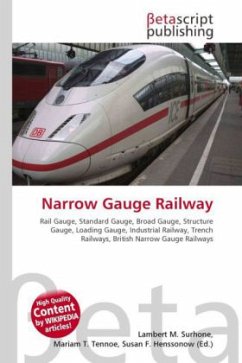Please note that the content of this book primarily consists of articles available from Wikipedia or other free sources online.A narrow gauge railway (or narrow gauge railroad) is a railway that has a track gauge narrower than the 1,435 mm (4 ft 8+1 2 in) of standard gauge railways. Most existing narrow gauge railways have gauges of 3 ft 6 in (1,067 mm) or less. Since narrow gauge railways are usually built with smaller radius curves and smaller structure gauges, they can be substantially cheaper to build, equip, and operate than standard gauge or broad gauge railways, particularly in mountainous terrain. The lower costs of narrow gauge railways mean they are often built to serve industries and communities where the traffic potential would not justify the costs of building a standard or broad gauge line. Narrow gauge railways also have specialized use in mines and other environments where a very small structure gauge makes a very small loading gauge necessary. On the other hand, standard gauge or broad gauge railways generally have a greater haulage capacity and allow greater speeds than narrow gauge systems.








